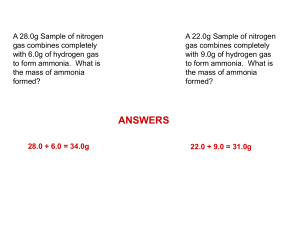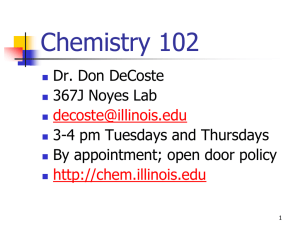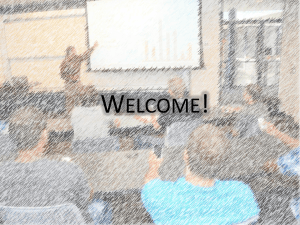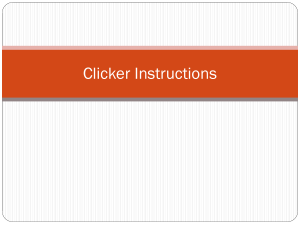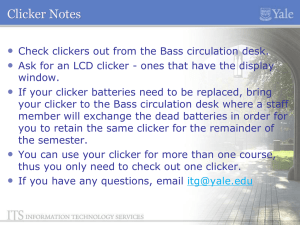Lecture 2
advertisement
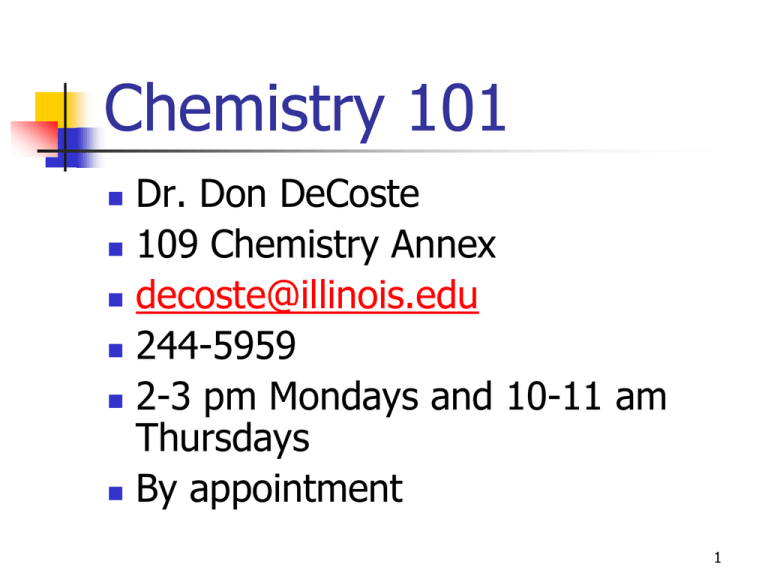
Chemistry 101 Dr. Don DeCoste 109 Chemistry Annex decoste@illinois.edu 244-5959 2-3 pm Mondays and 10-11 am Thursdays By appointment 1 To Do… http://chem.illinois.edu Slides on the website (after each lecture) Lab tomorrow (see Sig Fig video on website). Lon-Capa (HW1 Type 2 due Wednesday, January 29 by 7 pm). 2 Chemistry – Some Big Ideas Atoms have structure. Subatomic particles – electrons, protons, and neutrons. Atoms are mostly open space. Atoms can attract (and repel) one another. 3 Atomic Structure–So What? Bonds form within molecules. Molecules are sticky (forces between molecules). Different reactivities of elements (why is He in Mylar balloons?). Fireworks. Pools close during a thunderstorm. 4 Atomic Structure: How Do We Know? Thomson and the electron. Rutherford and the nucleus: http://www.youtube.com/watch?v=5pZj 0u_XMbc 5 Simple Model of an Atom 6 NOT A Correct View 7 Clicker Question How many of the following are true regarding the number of protons in an atom? I. Identifies the element. II. Gives the number of electrons in a neutral atom. III. Gives the number of neutrons in a neutral atom. IV. Tells the element’s atomic number. A) B) C) D) E) 0 1 2 3 4 8 Using The Periodic Table Element: neutral; defined by the number of protons. Ions: positive or negatively charged; comes from a differing number of electrons. Isotopes: atoms of the same element with differing number of neutrons. 9 Forming a Cation 10 Forming an Anion 11 Isotopes of Sodium 12 Using The Periodic Table Symbol, name, number of protons (all of these are related). Number of electrons in a neutral atom or in an ion. 13 Using The Periodic Table 14 Using The Periodic Table 15 Using The Periodic Table Formulas of some ionic compounds. Naming simple compounds. [Chapter 5 material] 16 Three Types of Binary Compounds Metal (Groups 1, 2, 3) and nonmetal Metal (transition) and nonmetal Simple naming: sodium chloride [NaCl], calcium bromide [CaBr2]. Roman numerals: iron(II) oxide [FeO]. Two nonmetals Prefixes: carbon dioxide [CO2]. 17 Three Types of Binary Compounds CaO CoO CO 18 Three Types of Binary Compounds CaO calcium oxide CoO cobalt(II) oxide CO carbon monoxide 19 Type I Compound CaO calcium oxide 20 Type I Compound CaO calcium oxide Charge Balance: Ca2+ O2(2+) + (2-) = 0 21 Type II Compound CoO cobalt(II) oxide 22 Type II Compound CoO cobalt(II) oxide 23 Type II Compound CoO cobalt(II) oxide Co2+ O2(2+) + (2-) = 0 Co2O3 cobalt(III) oxide Co3+ O22(3+) + 3(2-) = 0 24 Type III Compound CO carbon monoxide 25 Type III Compound CO carbon monoxide 26 Type I Compound Ca3P2 calcium phosphide 27 Type II Compound 28 Type III Compound N2O5 dinitrogen pentoxide 29 30 Polyatomic Ions Ammonium Nitrate Sulfate Hydroxide Phosphate Carbonate 31 Clicker Question Which of the following is the correct name for the compound with the formula MgF2? a) b) c) d) e) magnesium(II) fluoride magnesium difluoride magnesium fluoride magnesium fluorite magnesium fluorate 32 Clicker Question Which of the following is the correct name for the compound with the formula MgF2? a) b) c) d) e) magnesium(II) fluoride magnesium difluoride magnesium fluoride magnesium fluorite magnesium fluorate 33 Clicker Question Which of the following is named incorrectly? a) b) c) d) e) PCl3 KCl CuO Cu2O CO phosphorus trichloride potassium(I) chloride copper(II) oxide copper(I) oxide carbon monoxide 34 Clicker Question Which of the following is named incorrectly? a) b) c) d) e) PCl3 KCl CuO Cu2O CO phosphorus trichloride potassium(I) chloride copper(II) oxide copper(I) oxide carbon monoxide 35 Uncertainty in Measurement 36 Clicker Question How many significant figures should be reported? a) b) c) d) e) 1 2 3 4 5 37 Clicker Question How many significant figures should be reported? a) b) c) d) e) 1 2 3 4 5 38 Clicker Question What is the volume reading of the buret? a) b) c) d) e) 20.14 20.15 20.16 20.17 20.18 39 Clicker Question Leading zeroes are ____ significant, captive zeroes are ____ significant, and trailing zeros are ____ significant. a) b) c) d) e) always, always, always never, never, never sometimes, sometimes, sometimes never, sometimes, sometimes never, always, sometimes 40 Clicker Question Leading zeroes are ____ significant, captive zeroes are ____ significant, and trailing zeros are ____ significant. a) b) c) d) e) always, always, always never, never, never sometimes, sometimes, sometimes never, sometimes, sometimes never, always, sometimes 41 Clicker Question How many significant figures are in the measurement 0.030140 liters? a) b) c) d) e) 3 4 5 6 7 42 Clicker Question How many significant figures are in the measurement 0.030140 liters? a) b) c) d) e) 3 4 5 6 7 43 Clicker Question You add 82.4 mL of water in a graduated cylinder to 25 mL of water in a beaker. How much water should you report? a) b) c) d) e) 100 mL (1 significant figure) 110 mL (2 significant figures) 110. mL (3 significant figures) 107 mL (3 significant figures) 107.4 (4 significant figures) 44 Clicker Question You add 82.4 mL of water in a graduated cylinder to 25 mL of water in a beaker. How much water should you report? a) b) c) d) e) 100 mL (1 significant figure) 110 mL (2 significant figures) 110. mL (3 significant figures) 107 mL (3 significant figures) 107.4 (4 significant figures) 45 Restrictions on Reactions Element conservation. CHEMISTRY 102-104: Thermodynamics: Suniv must increase. Kinetics: time is a factor for reactions to occur. 46 Chemistry – Some Big Ideas Chemical changes are accompanied by energy changes. Reactions are due to breaking bonds and forming bonds. Exothermic versus endothermic. 47




